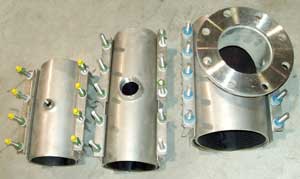Common water problems
Here are some common water supply problems that you may experience, and ways of solving them:
- No water
- Frozen pipes
- Poor pressure
- Leaking service pipes
- Hot tap water burns
- Discoloured water
- Clean-up after repairs
No water
No water at the tap can be caused by a variety of factors including:
- Old galvanized piping in house
- Plugged water softeners
- Broken faucets
- Plugged aeration screens on faucets
- Plugged water meter
- Water service or water main leaks
- Water turned off by the Water and Waste Department for cancellation or nonpayment of bill
- Possible frozen service (during winter)
For more information, contact 311, and we may be able to help you determine the cause of no water.
Frozen pipes
Poor pressure
The City's water pressure can vary slightly from area to area and during peak demand times, but on average the City pressure is 65 pounds per square inch.
Poor water pressure can be caused by a number of internal and external factors including:
- old galvanized piping in house
- plugged water softeners
- faulty taps
- plugged aeration screen
- plugged water meter
- water pipe or water main leaks
Leaking service pipes
Things you should know about water leaks:
- Not all leaks are the City's responsibility to repair. These water leaks include:
- a leak in your pipe
- a leak on a fire sprinkler system
- a leak on a combined fire and domestic service (fire protection and potable supply)
- Not all water discharges are leaks. What appears to be a leak may actually be:

- a sump pump discharging
- a swimming pool being pumped
- a lawn sprinkler system
- a backyard skating rink being flooded
- Our crews determine the cause of a leak before corrective measures begin.
- Before any water main break repairs or other excavation work can begin, all underground utilities (MTS, Hydro etc.) must, by law, be contacted.
- Scheduling can sometimes take hours or days to coordinate and complete.
- When we have been cleared to dig, a leak detection crew is dispatched to pin-point the leak.
- This process minimizes the size of the excavation and maximizes the efficiency of the excavation crew.
- When there is a leak on a City pipe, barricades are placed at the location to be excavated.
- Water under pressure (especially in frozen soil or under concrete roads) follows the path of least resistance. This means a leak on a pipe may not be located where the water appears on the surface.
- Things you should know about leaks on residential property
Clean-up after repairs
We perform more than 1,700 excavations annually to repair or maintain valves, water mains, water pipes and hydrants.
- During some repair or maintenance work, it is necessary to leave planks, plywood, signage or barricades on the excavation site even though the job has been completed. In these cases, the items remain for safety reasons because the material to complete the backfill may not be immediately available.
Excavation maintenance
- Boulevard excavations are mounded slightly with extra soil in anticipation of ground settlement.
- Excessive settlement may be the result of soil and/or seasonal conditions. Report these locations to 311 for maintenance.
- Public sidewalks, roadways and boulevards are cleaned up after an excavation has occurred.
- Seasonal conditions may prevent clean-up in a timely manner.
- We maintain excavations until final restoration can be completed by the Public Works Department.
Boulevard flood tamping
- Flood tamping activities occur from May to September.
- In Spring, when the ground has thawed, crews go to every boulevard excavation and force water into them to help compact the ground and to prevent further sinkage.
- Crews will add mud if required.
- After tamping, crews will pack and square up the excavation.
- Boulevard excavation locations are then passed to the Public Works Department for final restoration.
Contact 311 to inquire about an excavation.
